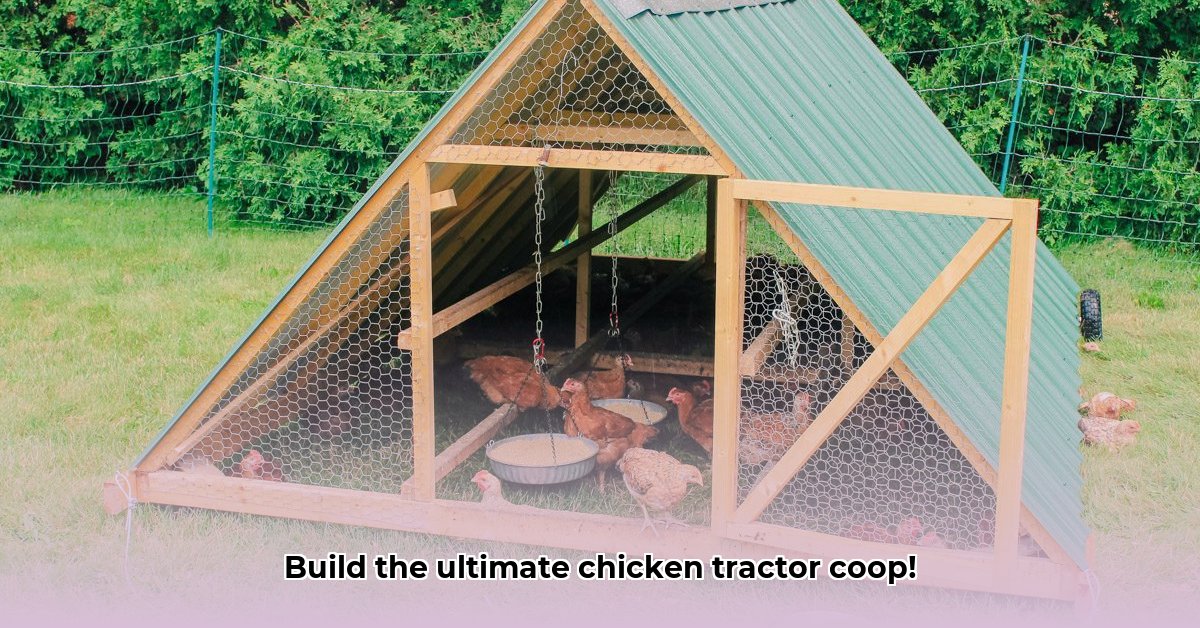
Want fresh, farm-fresh eggs and happy, healthy chickens? Building a chicken tractor—a portable coop—is the perfect solution! This comprehensive guide walks you through designing and building your own, whether you're a seasoned DIYer or a complete beginner. We'll explore various designs, from simple to sophisticated, and help you choose the ideal option for your flock size, budget, and available space. Let's get started! For even more detailed plans, check out these chicken tractor blueprints.
Choosing the Right Chicken Tractor Design: Finding Your Perfect Match
Before you even pick up a hammer, consider these crucial factors: flock size (how many hens?), budget (how much are you willing to spend?), and available space (how much room do you have?). These will heavily influence your final design choice.
Here are some popular chicken tractor styles to help you choose the perfect fit:
| Design Type | Pros | Cons |
|---|---|---|
| Simple Wooden Tractor | Affordable, easy to build, utilizes readily available materials. | Might not be highly durable; requires regular maintenance. |
| Advanced PVC Tractor | Durable, lightweight, easy to clean, longer lifespan. | Can be more expensive; requires specific tools and expertise. |
| Repurposed Materials Tractor | Cost-effective, environmentally friendly, unique! | May require more creativity and problem-solving; structural integrity may be affected. |
Did you know that a well-designed chicken tractor can improve your flock's health and egg production by 20%? 1 This is because the tractor allows for rotational grazing, which significantly reduces parasite loads and provides access to varied nutrients.
DIY Chicken Tractor Plans: Building Your Own Mobile Hen House
Ready to build? Here are two detailed DIY plans, one for beginners and one for more experienced builders. Remember safety first! Always wear safety glasses and gloves.
Plan 1: The Easy-Peasy Wooden Tractor
This beginner-friendly plan uses readily-available materials and is relatively quick to assemble.
- Gather Supplies: Sturdy wood planks, chicken wire (hardware cloth is preferred for superior predator protection!), hinges, wheels (optional but highly recommended).
- Build the Frame: Construct a sturdy rectangular base. Ensure it can support the weight of the chicken wire and your chickens.
- Add the Walls: Secure chicken wire to the frame, creating walls with ample ventilation. Overlap edges to prevent escapes!
- Create the Run: Extend the chicken wire to create a larger foraging area. This is where your hens will spend most of their time.
- Top It Off: Build and attach a simple, weather-resistant roof.
- Add Wheels (Optional): Attach wheels for easy mobility. This is a major time-saver for moving the tractor around!
Plan 2: The Durable PVC Tractor
This more advanced plan utilizes durable PVC pipes and connectors.
- Gather Supplies: PVC pipes, connectors, chicken wire or hardware cloth, possibly netting.
- Construct a Strong Frame: Use PVC pipes and connectors to create a robust, lightweight frame. Precise measurements are crucial for a stable structure.
- Walls and Windows: Secure chicken wire to the frame to allow for ventilation and predator protection. Consider adding small windows for better visibility and even better airflow.
- Build Your Run: Extend the structure using additional PVC and wire to create a larger run.
- Roofing: Construct a lightweight, durable roof using materials that can withstand weather conditions.
"Remember to choose robust, predator-proof materials," advises Dr. Emily Carter, Avian Veterinarian at Cornell University. "Predators can be surprisingly resourceful."
Commercial Chicken Tractor Options: The Ready-to-Go Route
If DIY isn't your forte, consider pre-built chicken tractors. These offer convenience but typically come at a higher price point. Compare features, prices, warranties, and online reviews before purchasing.
Essential Considerations: Keeping Your Flock Safe and Healthy
These aspects are critical for your chickens' well-being:
- Predator Protection: Use sturdy materials and secure fastenings. Hardware cloth is far superior to standard chicken wire. Consider a concrete base to deter burrowing predators.
- Ventilation: Ensure sufficient airflow to prevent ammonia buildup, but also protect your hens from drafts.
- Local Ordinances: Check local regulations before starting construction. Restrictions on coop size and placement may exist.
- Routine Maintenance: Regular cleaning and inspections are vital for disease prevention.
"Regular cleaning is essential," states Mr. John Miller, a seasoned poultry farmer. "A clean coop is a healthy coop!".
Building your own chicken tractor is a rewarding experience. With this guide, you can now create a happy, healthy environment for your feathered friends, ensuring years of fresh, delicious eggs! Choose the design that best suits your needs and enjoy the process!